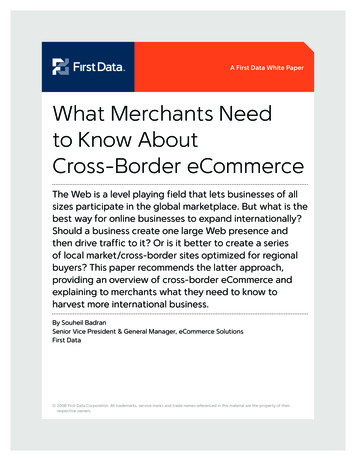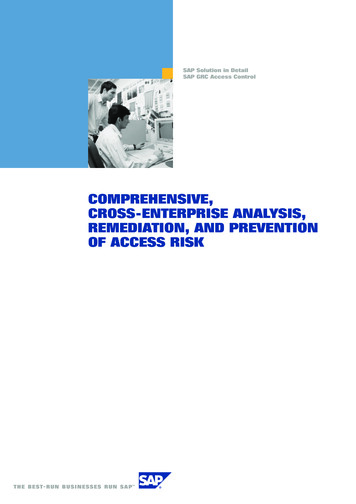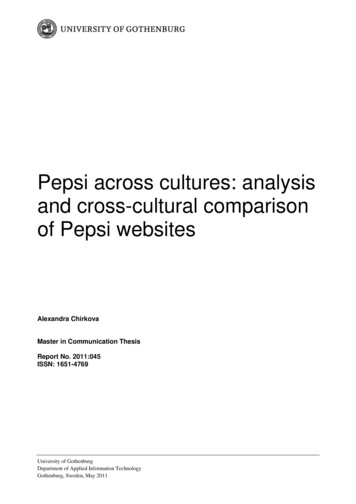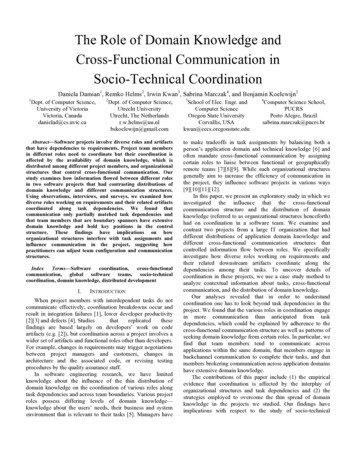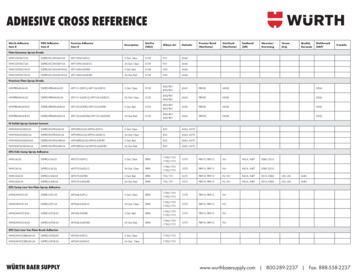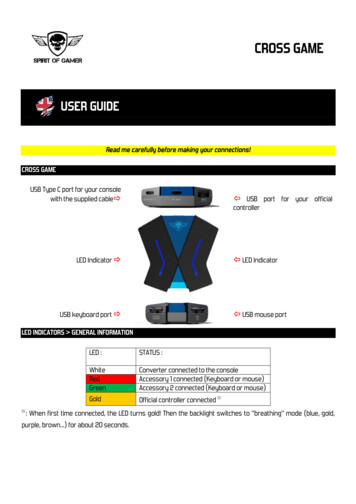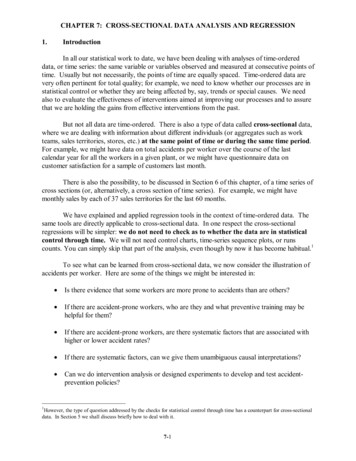
Transcription
CHAPTER 7: CROSS-SECTIONAL DATA ANALYSIS AND REGRESSION1.IntroductionIn all our statistical work to date, we have been dealing with analyses of time-ordereddata, or time series: the same variable or variables observed and measured at consecutive points oftime. Usually but not necessarily, the points of time are equally spaced. Time-ordered data arevery often pertinent for total quality; for example, we need to know whether our processes are instatistical control or whether they are being affected by, say, trends or special causes. We needalso to evaluate the effectiveness of interventions aimed at improving our processes and to assurethat we are holding the gains from effective interventions from the past.But not all data are time-ordered. There is also a type of data called cross-sectional data,where we are dealing with information about different individuals (or aggregates such as workteams, sales territories, stores, etc.) at the same point of time or during the same time period.For example, we might have data on total accidents per worker over the course of the lastcalendar year for all the workers in a given plant, or we might have questionnaire data oncustomer satisfaction for a sample of customers last month.There is also the possibility, to be discussed in Section 6 of this chapter, of a time series ofcross sections (or, alternatively, a cross section of time series). For example, we might havemonthly sales by each of 37 sales territories for the last 60 months.We have explained and applied regression tools in the context of time-ordered data. Thesame tools are directly applicable to cross-sectional data. In one respect the cross-sectionalregressions will be simpler: we do not need to check as to whether the data are in statisticalcontrol through time. We will not need control charts, time-series sequence plots, or runscounts. You can simply skip that part of the analysis, even though by now it has become habitual.1To see what can be learned from cross-sectional data, we now consider the illustration ofaccidents per worker. Here are some of the things we might be interested in: Is there evidence that some workers are more prone to accidents than are others? If there are accident-prone workers, who are they and what preventive training may behelpful for them? If there are accident-prone workers, are there systematic factors that are associated withhigher or lower accident rates? If there are systematic factors, can we give them unambiguous causal interpretations? Can we do intervention analysis or designed experiments to develop and test accidentprevention policies?1However, the type of question addressed by the checks for statistical control through time has a counterpart for cross-sectionaldata. In Section 5 we shall discuss briefly how to deal with it.7-1
2.Special Causes and Pareto AnalysisWhen we have cross-sectional data bearing on a single variable, the time-series analysesare no longer necessary. Rather, our attention focuses on the histogram. The histogram, by itsgeneral shape and/or its apparently outlying observations, offers hints as systematic and specialcauses that may be affecting the data. The analysis of histograms, however, doesn't lend itselfquite so easily to a systematic approach to data analysis. Even statisticians may draw more ontheir knack for detective work than their knowledge of statistical distributions.The general aim can be illustrated by applications to counting data, in which the Poissondistribution is a first thought for statistical model. If the Poisson distribution is appropriate, thedifferences between individual measurements are attributable to "chance", and there is neither a"Pareto effect" or any way to single out special causes. This will become clearer if we examine anapplication to error counts by operators.Operator ErrorsThe following study of operator errors gives cross-sectional data on errors in a givenmonth by 10 operators who were keying data into a computer. Even though the data have notime ordering, it is useful, purely for display, to look at them with a c-chart. The reason is this:if all operators are equally disposed to make errors, the observed cross-sectional histogram ofoperator errors should be compatible with the Poisson model (see Chapter 4, Section 1). We canget a quick, if rough, check on this assumption by looking for points outside of the control limitson c-chart, which are computed on the assumption that the Poisson distribution is applicable.Here are the notes for the data, contained in the text file OPERROR.sav:Variables:operator: ID of operator in data processing departmentfreq: frequency of data entry errors in December, 1987.All 10 operators entered about the same amount of data.Source: Gitlow, Gitlow, Oppenheim, and Oppenheim, "Telling theQuality Story", QUALITY PROGRESS, Sept., 1990, 41-46.We name the variables operator and freq as we import the file with SPSS.Next, we set up the c-chart as follows:7-2
In the chart below, we see that operators 4 and 9 are far above the UCL, suggesting that they weresignificantly more error prone. In the actual study, this finding was followed up, and it was found thatoperator 4's problems were correctable by glasses which permitted her to see better the numbers she wasworking with. (We have no report on operator 9.)Checking the reasonableness of the Poisson assumption can help in at least two ways: Better understanding of the cause system underlying the data. Identification of special causes.As already mentioned above, the exceptions are for Operators 4 and 9.Since the Poisson distribution seems inappropriate, there is an apparent "Pareto effect": a fewoperators account for a major fraction of the accidents. We now use SPSS to do Pareto analysis. Theappropriate procedure is Graphs/Pareto , which brings up the following dialog box:7-3
Notice that operator has been entered as the Category Axis variable. Be sure, also, to check the box forDisplay cumulative line.We see that the Pareto Chart is really just a bar chart that has been arranged in a special way. Itshows the “defects” from the various sources in descending order of magnitude from left to right. It alsoshows the cumulative percentage of the each contribution to the total number of defects. Thus we seethat Operator 4 was the person who had the most accidents (19 on the left vertical axis) and that hercontribution to the total was 38 percent (shown on the right vertical axis). Operator 9 was next with 17accidents, so that Operators 4 and 9 by themselves accounted for 72 percent of the total. Pareto analysisis one of the most useful of all the elementary statistical tools of quality management. In Juran's7-4
expression, it singles out the "vital few" problems from the "useful many", thus setting priorities forquality improvement.For example, a manufacturer studied failures of parts and discovered that seven of a very largenumber of part types accounted for nearly 80 percent of warranty defects, and that three of a large numberof branch locations accounted for a large percentage of warranty defects. Improvement efforts could thenbe concentrated on these parts and branches.In most applications this "Pareto effect" is so strong that its statistical significance is obvious.However, checking for the assumption of a Poisson distribution, which we have just illustrated by use ofc-chart in the example of Operator Errors, is useful in cases of doubt. Also, we can compare the meanand the square of the standard deviation (variance), since these two should be roughly equal if the Poissonassumption is valid.Library Book BorrowingThe statistical approach just illustrated is widely applicable. The next application concerns bookborrowing by the "customers" of a library. (It is also another example of a "lightning data set" -- the datacontained in LIBRARY.sav took just a few minutes to collect during a visit to the library.) Thedescriptive notes are:Number of loans of books in the Morton Arboretum Library, catalog category QK 477, as of 20November 1993. Data collected for 26 different books. Renewals not counted, but one borrowermight account for more than one loan of a given book.After naming the variable loans, for “number of loans”, we execute Descriptive Statistics:Note that 7.28*7.28 53.0 is much greater than the mean of 6.77. Hence, as is also shown by ac-chart below, the Poisson assumption is not tenable: some books are borrowed significantly morefrequently than others.7-5
Here is the Pareto chart:Five of the 26 books account for over half of the total loans, and half the books account for 92percent of the total. The Pareto effect is clearly at work here.Air Delays in October, 19877-6
We can study histograms to look for systematic and special causes in applications other than thoseentailing counting data. The application below is based on percentages of flights delayed for a crosssection of airlines, and we can use the normal distribution as a rough reference point for outlier search.The data are in the file AIRDELAY.sav:Percent of airline flights reported arriving on time in October,November, and December of 1987. "On time" means within 15minutes of schedule. From the Wall Street Journal, 9 February1988, page 7. There are two small revisions for November asreported in the WSJ of 7 January 1988.You see that the variables are named airline, dec87, nov87, and oct87 as we open the data inSPSS. Then we apply Descriptive Statistics to oct87. (This time in the Descriptives setup windowcheck the little box labeled Save standardized values as variables.)We are no longer working with counts so we will use a control chart to check on the behavior ofthe data. Remember that these are not time series data, but even when the sequence is irrelevant, the chartand its control limits can be useful in detecting outliers. We observe that Airline #10, Pacific Southwest,is right on the LCL. The histogram for Zoct87gives a similar result:Pacific Southwest is a good candidate for search for an assignable cause since its on-timeperformance is much worse than that of the other thirteen airlines, as is shown by the simple histogramabove. If, to the contrary, all fourteen airlines had been a part of the same "system" (to use an expressionof Deming), it is reasonable that we should see a histogram resembling what would be expected from a7-7
normal distribution; or at least that we should not see such a big gap between Pacific Southwest and theother thirteen airlines.Are there significant differences among these other thirteen? In Section 6, we shall show amethodology for approaching this question; as we shall see, it requires more data than the on-time arrivalsfor one single month.Performance Differences among Baseball TeamsThe SPSS data file named BASEBALL.sav contains five variables, won, lost, league, division,and city. The first two variables are the numbers of games won and lost at the time that activity ceasedbecause of the 1994 players’ strike. The indicator variable league equals zero for the American Leagueand one for the National League. For division the values are 1 for East, 2 for Central, and 3 for West. Inthe next few steps we shall look at the percentage of games won for each team. If the teams were aboutequal in their performances we would expect the distribution of those percentages to have the same shapeand spread as a binomial distribution where the chance of winning is 0.502.Before continuing, we must use Transform/Compute to define two new variables:total won lost andpct 100*won/totalHere is a partial glimpse of the SPSS worksheet after the transformations above:Next consider this display of Descriptive Statistics:We see that the average percentage of wins is close to 50 percent, and the mean number of gamesplayed by each team is about 114. If the performances of the teams differ only by chance, then we canapproximate the standard deviation of pct by the formulaSD 100 * 0.5 4.68291142If this is not intuitively obvious, think of each game as a coin toss with the chance of heads equal to the chance of tails (assuming that ateach game the teams are evenly matched).7-8
which comes from the mathematical theory of the binomial distribution. The actual standard deviation,however, is 6.84-- substantially larger than 4.68. Hence it appears, as we would expect, that the teamsdiffer by more than chance, and we must reject the hypothesis that they are from the same general“performance process.” The histogram shows something even more interesting:The distribution is bimodal (It has two peaks). There are too few teams close to 50 percent, the overallaverage. (Note: To make your own histogram look that same as that above you will have to go into theChart Editor and fiddle with the number of intervals and their width.)For a contrasting example, thedata set on the left gives no evidencethat anything other than chance factorscaptured by the binomial distributionare at work. These data are the final1994 standings for the InternationalLeague. You may enjoy working withthem!7-9
3.Simple Cross-Sectional RegressionsWhen we have more than a single variable in cross-sectional applications, we can use regressiontools in much the same way as for time-series data, but we have to be even more cautious about causalinterpretation. In this section, we consider two marketing applications to illustrate both the regressionmechanics and the interpretation of results.Sales Proposals and SalesThe first example, contained in SALEPROP.sav, entails data from a cross-sectional sample of 31sales representatives. It leads to a simple regression analysis in which the dependent variable is sales foreach sales representative and the independent variable is the number of written proposals prepared by thesales representative, each for a single month's time. Note that the data are listed by number of proposals,from low to high. There is no time sequence: there are 31 sales representatives for one single time period.Study of the relation of sales volume and selling proposalsprepared by sales representatives in geographical territories ofthe Chicago branch of an office supplies company during one month."Management believed that there is a direct relationship betweenthe number of proposals a sales representative prepares and thedollar volume of sales achieved in that month. It is thereforecompany policy to require each person to prepare at least eightwritten proposals per month."sales : sales in 1000.numprop: number of proposals.Here are the results of Descriptive Statistics:We see that mean sales for the 31 salespersons was 55,677 and the mean number of proposalswritten was about 13 and a half.Next, we perform a scatter plot with sales on the vertical axis and numprop on the other,followed by a simple linear regression analysis:7-10
The regression line does not appear to have a very large slope nor is R Square large. Theredoesn’t seem to be much of a linear relationship between sales and numprop.The regression coefficient 0.430 for numprop is not even close to having a p-value that would becalled significant, although it is positive. (If taken at face value, it would suggest an average increase of 430 in sales for each proposal since sales is expressed in units of 1000.)We have not discussed confidence intervals since Section 14 of Chapter 2, but the concept isalways useful. In this case we can add and subtract 2*0.78301 from 0.43032 to obtain approximate 957-11
percent confidence limits for the slope at -1.136 and 1.996. Since the confidence interval contains zero,our conclusion is the same as that from examining the p-value. Note from the display above that we calledfor confidence intervals while setting up the regression analysis. The more precise limits for thecoefficients of numprop are -1.171 and 2.032, a little wider than the approximation using plus and minustwo as the multiplier of the standard error.Since the regression does not yield a significant result, we generally would not do diagnosticchecking. However, to illustrate the diagnostic checking in cross-sectional regression, we show the twochecks that are generally applicable in cross-sectional regression: A histogram for standardized residuals. Scatter Plot for the standardized residuals vs. the standardized predicted values.7-12
There is just a hint of nonlinearity in this scatter plot: the small and large fitted values tend to havesmall residuals and intermediate fitted values tend to have large residuals. Examination of the values ofZRE 1 would show that the problem is caused by observation 31 at the lower right of the plot.A point such as 31 is sometimes referred to as an influence point because, as you can see in thescatter plots, if it were removed from the plot of sales on numprop, the remaining points would be moresuggestive of positive correlation. (Imagine moving point 31 even lower and farther to the right-- itwould really pull the regression line downwards.)One way to explore this aspect of the data is to model the possible nonlinearity directly byintroducing a new variablenumpropsq numprop*numpropand to regress sales on both numprop and numpropsq as shown below:3At best, the regression shows borderline significance. The p-values for the coefficients ofnumprop and numpropsq are on either side of 0.05. But numprop and numpropsq are themselveshighly correlated, and this makes the interpretation of the individual coefficients tricky (we'll see more ofthis in Section 5).What we need is an assessment of overall significance of the regression model, which now includestwo independent variables, numprop and numpropsq. As we have explained earlier, this assessment isavailable from the last part of the output showing sources of the sum of squared deviations. The key3As we say in Chapter 6 in connection with fitting a nonlinear time trend in the Diet application, the mathematical basis for this approachis as follows: Y a bX cX2 is the equation a second-degree polynomial (parabola). This equation is often useful in modeling “gentlycurving” nonlinear relationships.7-13
number is the p-value of 0.135 on the line for Regression. This gives a significance assessment for thewhole regression model. The number 0.135 does not suggest significance, since 0.135 is substantiallylarger than the rule of thumb, 0.05. So at best there is only a hint of a relation between proposals andsales.In one sense the study was disappointing: management's beliefs about the effectiveness of writtenproposals were not borne out. However, even if there had been a strong and positive relationship betweensales and the number of written proposals, there would have been ambiguity about the causalinterpretation. For example, it could have been possible that the best sales representatives were also wellorganized and could turn out more written proposals, yet at the same time the proposals themselves mighthave had little or no effect on sales.For a cleancut causal interpretation of a regression of Y on X, we would need some assurance thatthe observed relation in the regression would not be substantially altered if other variables affecting sales - say X1, X2, and X3 -- had been measured and introduced into the model.However, although the study is not conclusive, its results cast some doubt on the advisability ofmanagement pressure to increase the number of written proposals. There may be other, better, routes toimproved sales performance.One circumstance that provides greater clarity of causal inference is given by randomizedexperimentation. Here, for example, the number of proposals to be made by each sales representativewould be determined at random; remember the time-series application of randomized experimentation inSection 3 of Chapter 5.Absent randomized experimentation, we must simply make the best judgments about causationthat we can, given all our knowledge about the application.This sales
Since the Poisson distribution seems inappropriate, there is an apparent "Pareto effect": a few operators account for a major fraction of the accidents. We now use SPSS to do Pareto analysis. The appropriate procedure is

